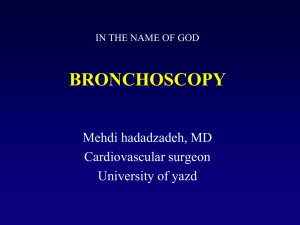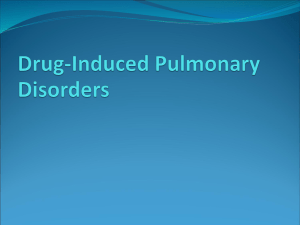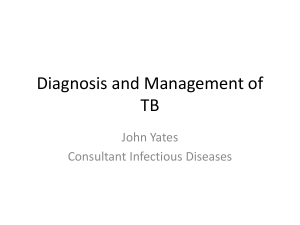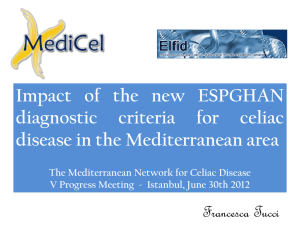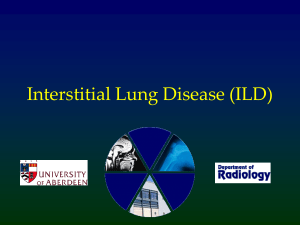146752.TEKAVEC_-_lektorirani
advertisement
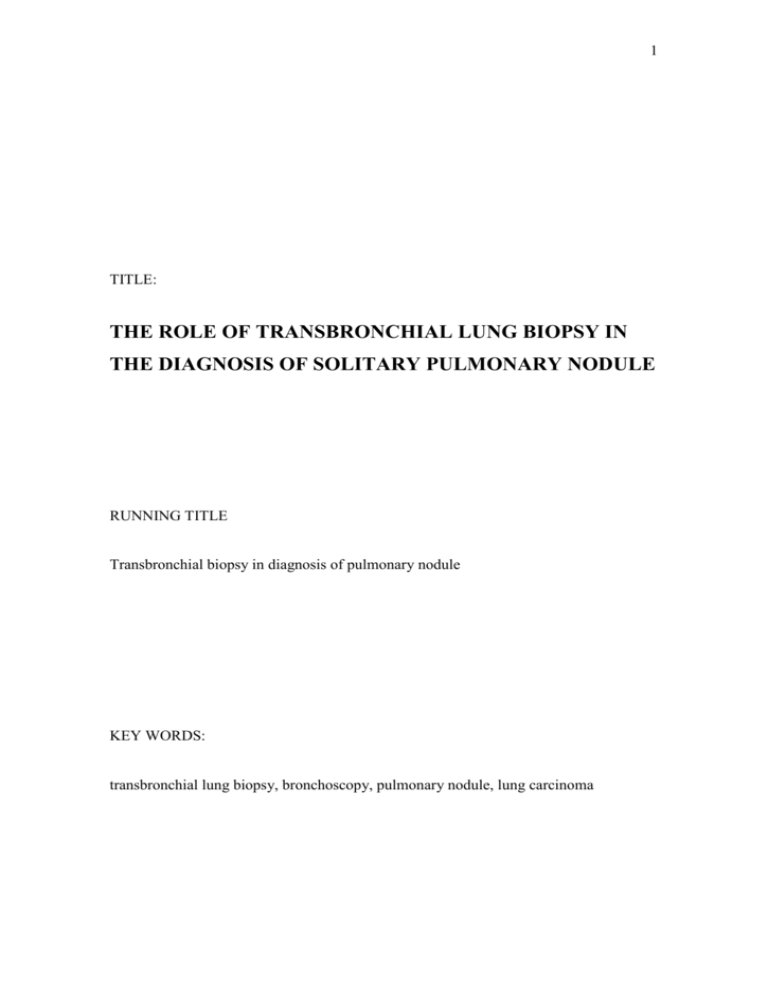
1 TITLE: THE ROLE OF TRANSBRONCHIAL LUNG BIOPSY IN THE DIAGNOSIS OF SOLITARY PULMONARY NODULE RUNNING TITLE Transbronchial biopsy in diagnosis of pulmonary nodule KEY WORDS: transbronchial lung biopsy, bronchoscopy, pulmonary nodule, lung carcinoma 2 AUTHORS: Jasna TEKAVEC, Tatjana PEROŠ-GOLUBIČIĆ, Danijel GROZDEK, Antonija IVIČEVIĆ i Marija ALILOVIĆ INSTITUTION:: Jordanovac University Hospital for Lung Diseases Zagreb, Croatia 3 ABSTRACT Background: Transbronchial lung biopsy (TBLB) is a well recognized diagnostic technique in diffuse interstitial lung diseases, but it is not considered to be the first choice in investigation of solitary pulmonary nodules (SPN). The main idea of this study was to increase the sensitivity of bronchoscopy using multiple techniques, especially TBLB, thus to avoid more aggressive diagnostic procedures. Objective: The objective of this prospective study was to evaluate the efficacy and safety of TBLB in the diagnosis of SPN, in comparison with other bronchoscopic techniques. Methods: Fifty patients with chest x-ray finding consistent with SPN underwent bronchoscopy with bronchial washing, brushing, bronchoalveolar lavage (BAL) and TBLB. Thirty-one patients suffered from malignant tumors, while 19 patients had nonmalignant lesions. Results: TBLB achieved overall diagnostic sensitivity of 62%, BAL of 29%, bronchial brushing of 16% and washing of 6%. Combining all techniques together, bronchoscopy had overall sensitivity of 86%. Concerning malignant lesions, TBLB had a sensitivity of 65%, specificity of 100%, and accuracy of 82%. TBLB had a significantly better yield for lesions with a diameter ≥25 mm than for lesions of <25 mm (sensitivity of 82% and 53% respectively, p<0.05). Diagnostic yield improved significantly with the increasing number of specimens (less than 3 specimens: sensitivity 59%, 3 or more specimens: sensitivity 87%, p<0.05). Complications of TBLB occurred in 2 (4%) patients: 1 incomplete pneumothorax and 1 hemorrhage. Conclusions: According to the results, we conclude that TBLB is an accurate and safe technique for the diagnosis of pulmonary solitary nodule with a diameter equal or greater than 25 mm. 4 INTRODUCTION Solitary pulmonary nodule (SPN) is described as a circumscribed lesion surrounded by normally ventilated lung parenchyma. Etiologically, it includes primary lung tumors, metastases of extrathoracic neoplasia, and various nonmalignant lesions (infections, vasculitides, some connective tissue diseases, amyloidosis, bronchial and vascular abnormalities, pulmonary infarction, etc.)1-2. It is important to note that patients with resectable primary peripheral lung carcinoma have better prognosis after surgical treatment than those with centrally localized carcinoma3. Early diagnosis of SPN is particularly important, but in some circumstances localization and size of the nodule tend to be so inconvenient that the diagnosis can only be established by open lung biopsy. Percutaneous needle – aspiration/biopsy is the most widely used technique in such case, although it may be associated with some complications4. Thoracoscopy and video assisted thoracoscopy (VATS) enable accurate lung biopsy in subpleural region but these techniques require complete surgical equipment5. Diagnostic yield of fiberoptic bronchoscopy for peripheral nodule is variable, ranging from 30% to 60%. Even if fiberoptic bronchoscopy is not the first choice to investigate a peripheral lesion, it may still be recommended to screen the airways, especially if there is a suspicion of malignancy6. Concerning safety and availability of bronchoscopy, there is a rational question: could we increase diagnostic sensitivity of bronchoscopy using a higher number of techniques (especially TBLB) and avoid other more aggressive diagnostic procedures? 5 PATIENTS AND METHODS Patients Fifty patients were included in this prospective study. The inclusion criteria were: 1) solitary pulmonary nodule on chest x-ray; 2) 2) unexplained diagnosis after cytologic and microbiologic examination of sputum (3 smears); 3) 3) signed informed consent; and 4) 4) normal bronchoscopic appearance (absence of any abnormality in the visible area of fiberoptic bronchoscope). Methods All patients underwent local anesthesia with 2 ml of 2%-Xylocaine solution applied directly to vocal cords, followed by 1 ml through bronchoscope to the trachea. We used Olympus T30 and T40 fiberoptic bronchoscope. Bronchial washing, brushing and TBLB were obtained in all patients, while bronchoalveolar lavage (BAL) was performed in 38 patients. Bronchial washings, brushings and BAL were cultured for Mycobacterium tuberculosis, nonspecific bacteria and fungi. Specimens obtained by TBLB were gently pressed to glass to make biopsy imprint, and then stored into 4%-formalin. All samples (including biopsy imprint) were cytologically examined using May Grünwald Giemsa staining. Biopsy specimens were microscopically analyzed using various stains (HE, Prussian blue, Mallory, etc.). Statistical analysis Sensitivity was analyzed by a modified Bayes’ theorem7 using the following formula and expressed as %: Sensitivity = [No of diagnostic findings / All patients] x 100 6 We used a modified Bayes’ theorem for malignant lesions in the following way: Sensitivity=[No of findings positive for malignancy /No of all patients with malignancy] x 100 Specificity=[No of findings negative for malignancy/No of patients without malignancy] x 100 Accuracy = [true positive + true negative / true negative + true positive + false negative + false positive] x 100 The impact of various conditions (diameter of nodule and number of biopsy specimens) on the sensitivity of TBLB was expressed by Fischer’s test of correlation for small samples. 7 RESULTS Fifty patients were included in the study: 42 male and 8 female, average age 59 years. Two patients had previously diagnosed malignant tumors (gastric cancer and breast cancer one each). Nineteen patients (38%) had nonmalignant lesions: 12 patients had tuberculosis and 7 patients suffered from various diseases (vasculitides 3, pulmonary infarctions 2, fibronodular lesion 1, and nodular type of BOOP 1 patient). Bronchoscopy was diagnostic in 18 patients and nondiagnostic in one patient with fibronodular lesion, who finally underwent VATS. In case of SPN, nonmalignat bronchoscopic finding is usually uncertain and requires additional proof to be definitely confirmed. The diagnosis of nonmalignant lesions was verified as follows: Tuberculosis was diagnosed on the basis of positive acid-fast bacilli and positive cultures for Mycobacterium tuberculosis in BAL fluid and/or histologic finding of caseating granulomatous inflammation. All 12 patients with the diagnosis of lung tuberculosis were successfully treated with antituberculotic drugs and post-treatment follow up period was 1 year. Histologic findings of pulmonary infarction (3 patients) were compatible with positive perfusion/ventilation scans. These patients recovered upon anticoagulant treatment and nodular pulmonary infiltrates completely disappeared. Patients with vasculitides (n=3) had ANCA positive sera. In one patient the diagnosis of vasculitis was additionally confirmed by biopsy of the skin and nasal mucosa. Two patients underwent renal biopsy, and histologic findings were consistent with Wegener granulomatosis. One patient with a histologic finding of BOOP (nodular type) was treated with carbamazepine during the preceding 8 months, and had hematologic and liver impairments consistent with drug adverse effect. According to histologic finding of TBLB we presumed that the nodular type of BOOP may have been induced by carbamazepine. Nodular pulmonary lesion completely disappeared on chest x-ray 8 weeks after drug discontinuation. The patient remained well during the 1-year follow up period. 8 Thirty-one (62%) patients suffered from malignant tumors as following: squamous cell carcinoma 13, adenocarcinoma 5, small-cell carcinoma 3, nodular type of bronchoalveolar carcinoma 2, large-cell carcinoma 1, neuroendocrine carcinoma 1, nondifferentiated carcinoma 4 patients, and 2 patients had metastases of extrathoracic malignant tumors. Bronchoscopy was diagnostic in 25 of these patients. In the remaining 6 patients diagnosis was made as follows: percutaneous needle biopsy – 4 patients, VATS – 1 patient, and open lung biopsy – 1 patient. TBLB achieved overall diagnostic sensitivity of 62%, BAL of 29%, bronchial brushing of 16% and bronchial washing of 6%. Combining all techniques, bronchoscopy had an overall sensitivity of 86% (Table 1). TBLB showed good results in the diagnosis of malignant lesions: sensitivity of 65%, specificity of 100% and accuracy of 82% (Table 2). TBLB had a significantly better yield in lesions with a diameter ≥25 mm than for lesions <25 mm: sensitivity of 82% and 53%, respectively, p < 0.05 (Table 3). Diagnostic yield from TBLB was significantly improved with the increasing number of specimens: less than 3 specimens – sensitivity of 59%, 3 or more specimens – sensitivity of 87%, p < 0.05 (Table 3). Complications of TBLB occurred in 2 (4%) patients: 1 hemorrhage and 1 pneumothorax. Complications were not life-threatening and did not require surgical treatment. Both patients were treated by rest and cough-suppressants. 9 DISCUSSION TBLB is a widely used diagnostic technique for diffuse interstitial lung diseases, however, it has not yet been established as the first choice procedure for SPN. Results of previously published studies differ from author to author, the sensitivity ranging from 37% to 74 % (Table 4). There are several reasons for that. Most of authors tend to avoid biopsy imprint for cytology, preserving the specimen exclusively for histopathologic examination. However, according to literature data, better results were achieved using both cytologic and histopathologic analyses of biopsy specimens. Another possible reason for variable results could be the ratio between malignant and nonmalignant lesions in various studies. Small biopsy samples are much more convenient for histopathologic, and especially cytologic analyses of malignant lesions, whereas the diagnosis of nonmalignant diseases (ex. vasculitides, chronic inflammation, pulmonary infarction, etc.) commonly require bigger tissue samples than those obtained by TBLB. In Ellis’ study, the sensitivity of TBLB for malignant and nonmalignant nodules was 69% and 10% respectively8. Adding other bronchoscopic techniques, especially BAL, the overall sensitivity raises to up to 86%, like in our study. It is well known that nodule size has a significant impact on the diagnostic result. Lai found a sensitivity of 35% for nodules smaller than 2 cm and even 65% for those exceeding 2 cm9. It has been recognized that the higher number of biopsy specimens raises the sensitivity of TBLB in diffuse interstitial lung diseases as well as in SPN. We found no false negative result when more than 4 biopsy specimens were obtained. Milman found the biopsies with <4 and 4 specimens to produce a sensitivity of 52% and 70%, respectively10. The rate of complications recorded in the present study was consistent with literature data (pneumothorax 0.03%-3%, hemorrhage 0.01%-4%)11. In comparison with percutaneous needle biopsy, TBLB showed lower sensitivity but better safety. Based on literature data, the sensitivity of percutaneous needle biopsy ranges from 76.4% to 84%, with the rate of pneumothorax from 3.7% to 26%12,13. 10 Based on the study results, it is concluded that TBLB is an accurate and safe technique for the diagnosis of SPN with a diameter of 25 mm. Using fiberoptic bronchoscopy with TBLB and BAL as the first choice technique, the more aggressive diagnostic procedures that often require surgical equipment can be avoided. 11 Table 1. SENSITIVITY OF BRONCHOSCOPIC TECHNIQUES Technique No of diagnostic samples/ No of patients Sensitivity (%) TBLB (overall results) 36 / 50 62 TBLB (histology) 29 / 50 58 TBLB (citology) 21 / 50 42 Brushing 8 / 50 16 Bronchial washing 3 / 50 6 BAL 11 / 38 29 Bronchoscopy (overall results) 43 / 50 86 12 Table 2. DIAGNOSTIC VALUE OF VARIOUS BRONCHOSCOPIC TECHNIQUES IN MALIGNANT LESIONS Technique False negative / true positive Sensitivity (%) Specificity Accuracy (%) (%) TBLB (overall results) TBLB (histology) TBLB (citology) 11 / 31 14 / 31 18 / 31 65 55 42 100 100 100 82 78 74 Brushing 24 / 31 23 100 68 Bronchial washing 29 / 31 6 100 63 BAL 17 / 23 26 100 69 Bronchoscopy (overall) 6 / 31 81 100 89 13 Table 3. ROLE OF NODULE SIZE AND NUMBER OF SPECIMENS Diagnostic biopsies Nondiagnostic Total biopsies Sensitivity (%) 9 8 53 Significance Lesion diameter <25 mm 17 p = 0.0358 ≥25 mm 27 6 33 82 1–2 16 11 27 59 3 or more 20 3 23 87 No of specimens p = 0.0298 14 Table 4. LITERATURE DATA ON TBLB SENSITIVITY IN DIAGNOSIS OF SOLITARY PULMONARY NODULES Author No of patients TBLB sensitivity (%) Bronchoscopy – overall sensitvity (%) Shiner 14 (h+c) 51 65 75 Obara 15 (h+c) 226 74 not available Bilaceroglu 16 (h) 92 49 68 Milman 10 (h) 279 55 not available Debeljak 17 (h+c) 61 71 not available Katis18 (h) 37 38 46 Gasparini19 (h) 557 54 not available Mak 20 (h) 63 37 55,6 Chechani21 (h) 49 59 73 Ellis 8 (h+c) 78 68 not available (h) = histologic examinations of specimens were exclusively performed (h+c) = both histology and citology of biopsy imprint were performed 15 REFERENCES 1. MCCLURE, C. D., K. R. BOUCOT, G. A. SHIPMAN, A. G. GILLIAN, B. K. MILMORE, J. W. LLOYD, Arch. Environ. Health., 3 (1961) 127. – 2. LILLINGTON G. A., Systematic diagnostic approach to pulmonary nodules. In: FISHMAN A. P. (Ed.): Pulmonary diseases and disorders. (McGraw-Hill, New York, 1988). – 3. COULTAS D. B., J. M. SAMET, C.L. WIGGINS, C. BUTLER, E. S. SWEENEY, T. PARZYCK, Am. Rev. Respir. Dis., 133 (1986) 302. – 4. ZAVALA D. C., G. N. BEDEL, Am. Rev. Respir. Dis., 106 (1972) 186. – 5. COLTHARP W. H., J. H. ARNOLD, W. C. ALFORD, Ann. Thorac. Surg., 53 (1992) 776. – 6. DIAZ-JIMENEZ J.,. Diagnostic approach of solitary pulmonary nodules. In: STRAUSZ J. (Ed.): Pulmonary endoscopy and biopsy techniques. (European Respiratory Society Journals Ltd, Sheffield, 1998). – 7. IVANKOVIĆ D., B. KOPJAR, S. VULETIĆ, Vjerojatnost. In: IVANKOVIĆ D. (Ed.): Osnove statističke analize za medicinare. (Medicinski fakultet Sveučilišta u Zagrebu, Zagreb, 1991). – 8. ELLIS J. H, Chest, 68 (1975) 524. – 9. LAI R. S., S. S. LEE, Y. M. TING, H. C. WANG, C. C. LIN, Y. LU, Respir. Med., 90 (1996) 139. – 10. MILMAN N., P. FAURSCHOU, E. P. MUNCH, G. GRODE, Respir. Med. 88 (1994) 749. – 11. REID P. T., R. M. RUDD, Diagnostic investigation in lung cancer. In: SPIRO S. G. (Ed.): Carcinoma of the lung. (European Respiratory Society Journals Ltd, Sheffield, 1995). – 12. WILLIAMS A. J., S. SANTIAGO, S. LEHRMAN, R. POPPER, Am. Rev. Respir. Dis., 136 (1987) 452. – 13. PONGRAC I., M. ROGLIĆ, H. HARAMBAŠIĆ, Lijec. Vjesn., (1986) 108. – 14. SHINER J., J. ROSENMAN, I. KATZ, N. REICHART, E. HERSHKO, A. YELLIN, Thorax, 43 (1986) 887. – 15. OBARA M., H. SATOH, H. ISHIKAWA, Oncol. Rep., 5 (1998) 1237. – 16. BILACEROGLU S., Z. KUMENOGLU, H. ALPER, Respiration, 65 (1998) 49. – 17. DEBELJAK A., M. MERMOLJA, J. ŠORLI, M. ZUPANČIĆ, M. ZORMAN, J. REMŠKAR, Respiration, 61 (1994) 226. 16 Correspondence to: Dr. J. Tekavec-Trkanjec Jordanovac University Hospital for Lung Diseases Jordanovac 104 HR-10000 Zagreb CROATIA phone: +385 1 4580 745 e-mail: jasna.tekavec-trkanjec@zg.hinet.hr 17 NASLOV RADA ZNAČENJE TRANSBRONHALNE BIOPSIJE U DIJAGNOSTICI SOLITARNIH PERIFERNIH PLUĆNIH LEZIJA SAŽETAK: Transbronhalna biopsija pluća (TBBP) etablirana je tehnika u dijagnostici difuznih intersticijskih plućnih bolesti, ali se relativno rijetko koristi u dijagnostici solitarnih perifernih plućnih nodusa (SPN). Dijagnostička osjetljivost bronhoskopije može se povećati istodobnim korištenjem više bronhoskopskih tehnika, naročito transbronhalne biopsije pluća. Cilj ovog prospektivnog istraživanja bila je evaluacija učinkovitosti i sigurnosti transbronhalne biopsije pluća u dijagnostici SPN. Metode: U istraživanje je uključeno 50 bolesnika s nalazom SPN na rentgenskoj snimci pluća. Tijekom bronhoskopije korištene su slijedeće tehnike: aspirat bronha, bris četkicom, bronhoalveolarna lavaža (BAL) i TBBP. Kod 31 bolesnika dijagnosticiran je zloćudni tumor, a u 19 bolesnika radilo se o dobroćudnim nodusima. Rezultati: Najviše dijagnostički značajnih uzoraka dobiveno je transbronhalnom biopsijom (osjetljivost 62 %), potom BAL-om (29 %) i brisom (16 %), a najmanje bronhoaspiratom (6 %). Kombinacijom svih bronhoskopskih metoda osjetljivost bronhoskopije u cjelini bila je 86 %. Ako se posebno izdvoje samo tumorske lezije, osjetljivost TBBP je bila 65 %, specifičnost 100 %, a pouzdanost 82 %. Osjetljivost TBBP za lezije < 25 mm bila je 53 %, a za lezije promjera ≥25mm i veće 82 %, što je statistički značajna razlika na razini p < 0.05. Broj bioptata je statistički značajno utjecao na osjetljivost TBBP (do tri bioptata: osjetljivost 59 %, tri ili više bioptata: osjetljivost 87 %, p < 0.05). Kompikacije su se pojavile u dvoje (4 %) bolesnika (jedan pneumotoraks i jedno krvarenje). Zaključak: Na temelju navedenih rezultata može se zaključiti da je TBBP pouzdana i relativno sigurna metoda u dijagnostici perifernih solitarnih plućnih lezija promjera ≥25. 18 References: 1 McClure CD, Boucot KR, Shipman GA, Gillian AG, Milmore BK, Lloyd JW. The solitary pulmonary nodule and primary lung malignancy. Arch Environ Health 1961; 3: 127-9. 2 Lillington GA. Systematic diagnostic approach to pulmonary nodules. In: Fishman AP, ed. Pulmonary diseases and disorders, 2nd ed. New York: McGraw-Hill, 1988: 1945-54. 3 Coultas DB, Samet JM, Wiggins CL, Butler C, Sweeney ES, Parzyck T. Clinical features of a population-based series of patients with lung cancer presenting with a solitary nodule. Am Rev Respir Dis 1986; 133: 302-6. 4 Zavala DC, Bedel GN. Percutaneous lung biopsy with a cutting needle. Am Rev Respir Dis 1972; 106: 186-93. 5 Coltharp WH, Arnold JH, Alford WC et al. Videothoracoscopy: improved technique and expanded indications. Ann Thorac Surg 1992; 53: 776-9. 6 Diaz-Jimenez JP. Diagnostic approach of solitary pulmonary nodules. In: Strausz J, ed. Pulmonary endoscopy and biopsy techniques. Sheffield: European Respiratory Society Journals Ltd, 1998: 181-92. (Rossi A, ed. European Respiratory Monograph; vol 3). 7 Ivankovic D, Kopjar B, Vuletic S. Vjerojatnost. In: Ivankovic D, ed. Osnove statisticke analize za medicinare. Zagreb: Medicinski fakultet Sveucilista u Zagrebu; 1991: 82-5. 8 Ellis JH. Transbronchial lung biopsy via the fiberoptic bronchoscopy. Chest 1975; 68:524-31. 9 Lai RS, Lee SS, Ting YM, Wang HC, Lin CC, Lu jY. Diagnostic value of transbronchial lung biopsy under fluoroscopic guidance in an endemic area of tuberculosis. Respir Med 1996; 90: 139-43. 10 Milman N, Faurschou P, Munch EP, Grode G. Transbronchial lung biopsy through the fibre optic bronchoscope. Results and complications in 452 examinations. Respir Med 1994; 88: 749-53. 11 Reid PT, Rudd RM. Diagnostic investigation in lung cancer. In: Spiro SG, ed. Carcinoma of the lung. Sheffield: European Respiratory Society Journals Ltd, 1995: 188-212. (Yernault JC, ed. European Respiratory Monograph; vol 1). 12 Williams AJ, Santiago S, Lehrman S, Popper R. Transcutaneous needle aspiration of solitary pulmonary masses: how many passes? Am Rev Respir Dis 1987; 136: 452-4. Pongrac I, Roglić M, Harambašić H. Citološka transtorakalna aspiracijska punkcija. Lijec Vjesn 1986; 108-81. 13 14 Shiner J, Rosenman J, Katz I, Reichart N, Hershko E, Yellin A. Bronchoscopic evaluation of peripheral lung tumors. Thorax 1988; 43: 887-9. 15 Obara M, Satoh H, Ishikawa H, et al. Diagnostic procedures in obtaining pathological materials for pulmonary nodules due to primary lung cancer. Oncol Rep 1998; 5 (5): 1237-9. 16 Bilaceroglu S, Kumenoglu Z, Alper H et al. CT bronchus sign-guided bronchoscopic multiple diagnostic procedures in carcinomatous solitary pulmonary nodules and masses. Respiration 1998; 65: 49-55. Debeljak A, Mermolja M, Šorli J, Zupančič M, Zorman M, Remškar J. Bronchoalveolar lavage in the diagnosis of peripheral primary and secondary malignant tumors. Respiration 1994; 61: 226-30. 17 19 18 Katis K, Inglesos E, Zachariadis E et al. The role of transbronchial needle aspiration in the diagnosis of peripheral lung masses and nodules. Eur Respir J 1995; 8: 963-6. 19 Gasparini S, Feretti M, Secchi EB, Badelli S, Zuccatosta L, Gusella P. Integration of transbronchial and percutaneous approach in the diagnosis of peripheral pulmonary nodules or masses. Experience with 1,027 consecutive cases. Chest 1995; 108: 131-7. 20 Mak VHF, Johnston IDA, Hetzel MR, Grubb C. Value of washings and brushings at fiberoptic bronchoscopy in the diagnosis of lung cancer. Thorax 1990; 45: 373-6. 21 Chechani V. Bronchoscopic diagnosis of solitary pulmonary nodules and lung masses in the absence of endobronchial abnormality. Chest 1996; 109: 620-5.

